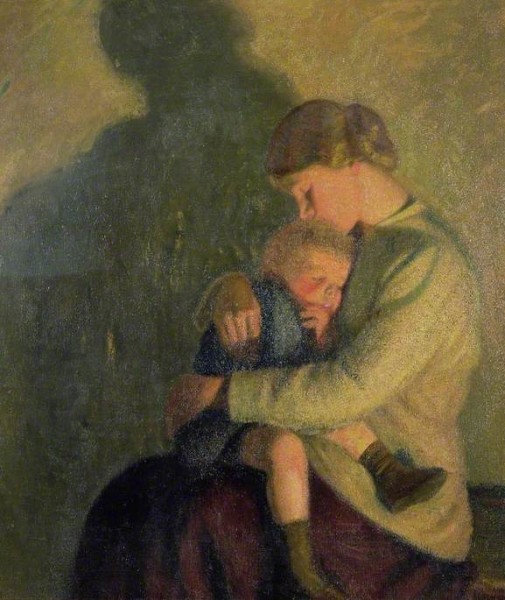Tucked away in a corner of the upper galleries at Cheltenham Art Gallery and Museum (The Wilson) is a large but very calm and simple painting by the Gloucestershire (South Cotswolds) based painter Sir William Rothenstein. Although purist art-historians might protest that he is a Bradford or London painter I would suggest that whilst he was born and brought up in Bradford and went on to the Slade School of Fine Art in London before becoming a significant London based teacher he was nevertheless at home (literally) in the village of Far Oakridge, above Stroud, in Gloucestershire. It was in this hill country that he quickly engaged with the craftsmen and artists of the Arts & Crafts movement based in the area. In the very important Arts & Crafts Gallery at Cheltenham are two other paintings which are directly connected with the Far Oakridge area – firstly, a work depicting a number of the Craftsmen and, secondly, a painting titled ‘The Storm’, of his own house, Iles Farm, at Far Oakridge which he had renovated in the early 1920’s with the help of craftsmen of the Arts & Crafts group.
The painting which is the subject of this blog seems to exude the peace and calm of his family growing up in the Cotswolds – including his sons John and Michael, who both became themselves eminent in the Arts, John as Director of the Tate Gallery and Michael as a pioneering print-maker. The painting has, in my hearing, often been dismissed as lightweight or sentimental – and therefore not worthy of serious consideration. I would profoundly disagree on two main scores. Firstly, this work is about humanity – about concern and love – of home comforts and domesticity – of family love and life. It reflects the painter’s own circumstances – the peace and tranquillity of the South Cotswold countryside and his and his family’s haven from the angst of life in London. Secondly, the work reflects Rothenstein’s understanding and appreciation of contemporary art – a light kindled as a student at the progressive Slade School of Art and in Paris. The grandiose statements, overwhelming detail, and cold ‘fussiness’ of the fashionable and ‘official’ art of the nineteenth century in both Britain and Europe was being severely questioned, by the Impressionists and Post-Impressionists amongst others. The Slade School was a conduit, a weapon, for British artists leading to a stripping of all unnecessary detail and ornamentation – concentrating on the fundamental essence of the subject. The strong influence of people like Monet and Gauguin can be seen in the progressive British art groups in Britain, from the New English Art Group in London, to the Glasgow School, to prominent regional groups such as the Cheltenham Art Group (founded in 1920).
William Rothenstein was in the thick of this exciting new approach – as a painter, as a teacher, and as a pioneering re-organiser of the old Government School of Design into the Royal College of Art which soon became a rival to the Slade as the cradle of modern British art. In Britain two main strands emerged based on this radical new approach to art – firstly, the rise of pure non-figurative abstraction and, secondly, the rise of a purist, minimalist, approach to painting rooted in the person and place, the place being Britain, and, in relation to Rothenstein, the South Cotswolds.
‘Mother and Child by Candlelight’ is a good example of this modern British approach – pairing away interfering detail and focussing upon the fundamental subject matter. It is a work to be contemplated at leisure – its atmosphere and ethos gradually absorbed.
David Addison. October 20th 2018.

